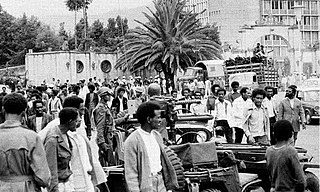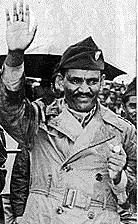Related Research Articles

Mengistu Haile Mariam is an Ethiopian former politician and former army officer who was the head of state of Ethiopia from 1977 to 1991 and General Secretary of the Workers' Party of Ethiopia from 1984 to 1991. He was the chairman of the Derg, the socialist military junta that governed Ethiopia, from 1977 to 1987, and the president of the People's Democratic Republic of Ethiopia (PDRE) from 1987 to 1991.

The Derg, officially the Provisional Military Administrative Council (PMAC), was the Marxist-Leninist military dictatorship that ruled Ethiopia, then including present-day Eritrea, from 1974 to 1987, when the military leadership or junta formally "civilianized" the administration but stayed in power until 1991.

LijEndelkachew Makonnen was an Ethiopian politician. Born in Addis Ababa, his father, Ras Betwoded Makonnen Endelkachew, served as Prime Minister of Ethiopia in the 1950s. Endelkachew Makonnen was a member of the aristocratic Addisge clan that were very influential in the later part of the Ethiopian monarchy. He would be the last Imperial Prime Minister appointed by Emperor Haile Selassie. He was a stepson of Princess Yeshashework Yilma, Emperor Haile Selassie's only niece.

The Eritrean War of Independence was a war for independence which Eritrean independence fighters waged against successive Ethiopian governments from 1 September 1961 to 24 May 1991.

After World War II, Ethiopia began to receive economic development aid from the more affluent Western countries. Originally the United Kingdom was the primary source of this aid, but they withdrew in 1952, to be replaced by the United States. Between 1950 and 1970, one source estimated that Ethiopia received almost US$600 million in aid, $211.9 million from the US, $100 million from the Soviet Union and $121 million from the World Bank. Sweden trained the Imperial Bodyguard and India at one point contributed the majority of foreign-born schoolteachers in the Ethiopian educational system.

The Ethiopian Civil War was a civil war in Ethiopia and present-day Eritrea, fought between the Ethiopian military junta known as the Derg and Ethiopian-Eritrean anti-government rebels from 12 September 1974 to 28 May 1991.

Lieutenant Colonel Atnafu Abate was an Ethiopian military officer and a leading member of the Derg, the military junta which deposed Emperor Haile Selassie and ruled the country for several years.
The Confederation of Ethiopian Labor Unions (CELU) was an umbrella organization that represented a number of labor unions and employee self-help associations in Ethiopia. The Derg, the military junta which ruled Ethiopia at the time, banned the organization and replaced it with the All-Ethiopian Trade Union 8 January 1977.

Emperor Haile Selassie proclaimed a revised constitution in November 1955 of the Ethiopian Empire. The new constitution was intended to improve Ethiopia's international image. While it consolidated the Emperor's absolutist powers it introduced concepts such as the separation of powers and expanded the role of the Ethiopian parliament. It was abrogated in 1974 with the Ethiopian revolution of that year which resulted in the abolition of the monarchy by the Derg.

Ethiopia has had four constitutions:

The 1960 Ethiopian coup d'etat attempt was perpetrated against Emperor Haile Selassie on 13 December 1960. The Council of the Revolution, four conspirators led by brothers Germame Neway and Brigadier General Mengistu Neway, commander of the Kebur Zabagna, sought to overthrow the Emperor during a state visit to Brazil in order to install a progressive government. The coup leaders declared the beginning of a new government under the rule of Haile Selassie's eldest son, Crown Prince Asfaw Wossen, that would address the numerous economic and social problems Ethiopia faced. The Council gained control of most of the capital city, Addis Ababa, and took several ministers and other important people hostage. After its initial success, the majority of the military and populace quickly aligned against the coup, and by 17 December loyalists had regained control of Addis Ababa. At least 300 people were killed during the coup, including most of the conspirators.
Captain Alemayehu Haile was a member of the Derg, the military junta that ruled Ethiopia from 1974 to 1987.
Democracia is the organ of the Ethiopian People's Revolutionary Party. It was launched as a clandestine weekly newspaper in July 1974, as the Central Committee of the Ethiopian People's Liberation Organization returned to Ethiopia from exile. At the time the EPRP was often known simply as the Democracia group, as the existence of the party was not publicly known.
The Ethiopian Marxist–Leninist Revolutionary Organization, commonly known by its Amharic acronyms Malered or Emelared, was a communist organization in Ethiopia active from 1974 to the late 1970s.
The Union of Ethiopian Marxist–Leninist Organizations, known by its Amharic acronym Imaledih, was a coalition of communist organizations in Ethiopia active between 1977 and 1979. Imaledih was intended as a pre-party formation, Imaledih was supposed function as the nucleus of new proletarian party. Through Imaledih, the constituent parties of the coalition would merge. The formation of Imaledih was actively supported by the ruling Derg military junta.
Abyotawit Seded was a communist organization in Ethiopia, formed in 1976 by a group of officers of the Derg military junta who had attended political trainings in the Soviet Union from 1975 and onwards.
The Labour League, generally known by its Amharic name Waz or the hybrid name Waz League, was a Marxist organization in Ethiopia active between 1975 and 1979, allied with the Derg military junta. Waz League was founded by Dr. Sennai Likkay, a veteran leader of the student movement.
The Provisional Office for Mass Organizational Affairs was a political organization in Ethiopia active between 1975 and 1979. POMOA functioned as a forum to involve different Marxist-Leninist organizations in the revolutionary process and to politicize and organize the masses.
The Commission for Organizing the Party of the Working People of Ethiopia, generally known by its English acronym COPWE, was a political organization in Ethiopia during the rule of the Derg. COPWE was a preparty organization; it had the task of preparing the Ethiopian people for creation of a communist party. In the absence of a communist party, COPWE functioned as a temporary replacement of the party that it would create.
Alemu Abebe is an Ethiopian politician. He served as mayor of Addis Ababa during the years of Red Terror.